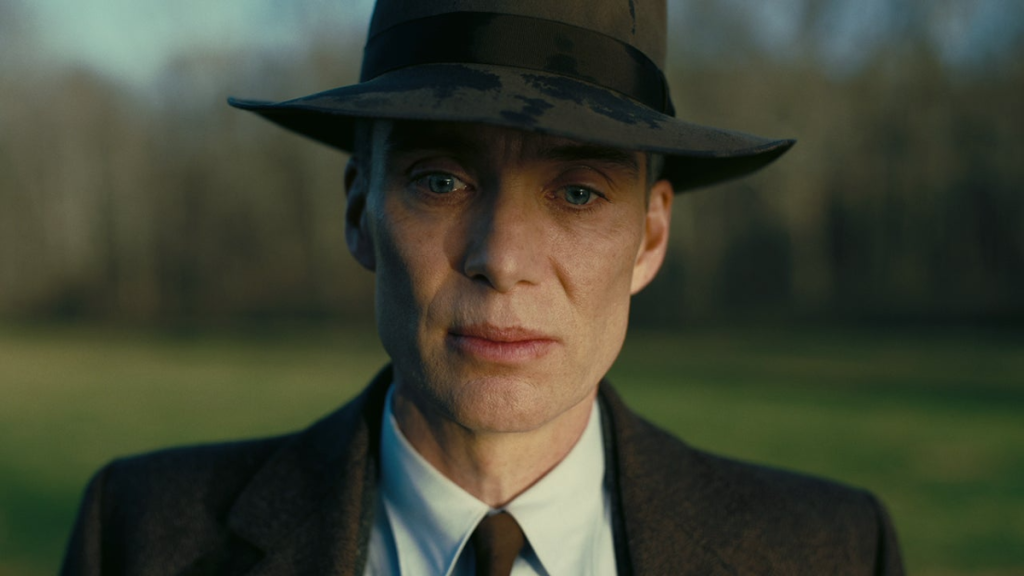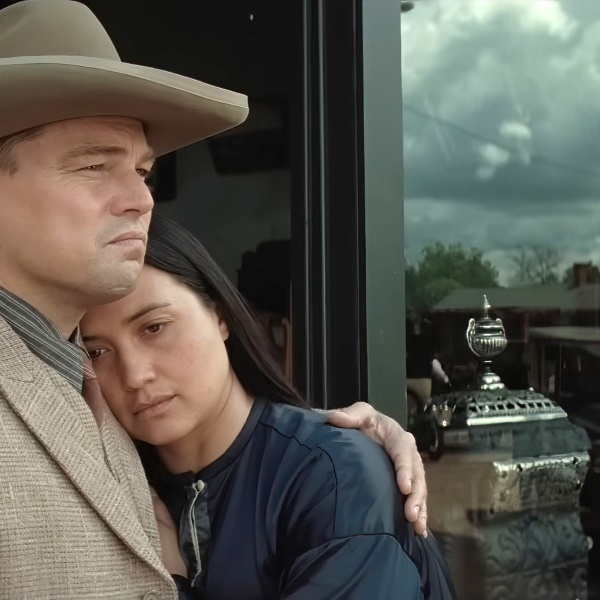At first, I thought that if J. Robert Oppenheimer didn’t exist, Christopher Nolan would probably have been compelled to invent him. The exalted British filmmaker has long been fixated upon stories of haunted and potentially self-destructive men who sift through the source code of space-time in a desperate bid to understand the meaning of their own actions, and so the “father of the atomic bomb” — a theoretical physicist whose obsession with a twilight world hidden inside our own led to the birth of the modern age’s most biblical horrors — would seem to represent an uncannily perfect subject for the “Tenet” director’s next epic. And he is. In fact, Oppenheimer is so perversely well-suited to the Nolan treatment that I soon began to realize I had things backwards: Christopher Nolan only exists because men like J. Robert Oppenheimer invented him first.
Which isn’t to overstate the degree to which Nolan’s first biopic feels like some kind of grandiose self-portrait (even if the Manhattan Project sequences can seem broadly analogous to the filmmaking process, as large swaths of “Inception” and “The Prestige” did before them), nor to suggest that the director sees himself in the same regard as the man he describes in the “Oppenheimer” press notes as “the most important person who ever lived.” It’s also not to glibly conflate one of the most controversial figures of the 20th century with one of the most controversial figures on the r/Movies subreddit, even if the industry-changing success of “Batman Begins” surely inspired a “now I am become death” moment of Nolan’s very own.
It’s just to say that Nolan has always been fascinated by characters who are torn between the subatomic particles of personal agency and the vast cosmic forces of our universe, and J. Robert Oppenheimer was perhaps the first person who actually lived a version of the only story that Nolan has ever wanted to tell. So while Nolan’s first biopic may not be a self-portrait, it is an origin story of sorts, and also a devastating statement of purpose. It’s his “Empire of Light.” It’s his “Roma.” Most uncomfortably — and most unfavorably — it’s his “The Wind Rises.”
Oppenheimer’s reluctant obsession with engineering the deadliest weapon ever built — and the Promethean torture he received as a reward for such a terrible misuse of his genius — left behind the most awful proof that human beings are more infinite and unknowable than even the greatest mysteries of quantum mechanics. That paradox has gripped Nolan since the beginning. It’s given us the sight of Hugh Jackman staring at his own drowned body in a jar, and resulted in lines of dialogue like “Love is the one thing we’re capable of perceiving that transcends dimensions of time and space.” The filmmaker’s previous attempts to make sense of it have taken him forwards in time and deep into the stars, and now — with a thunderously intimate character study that often unfolds like the loudest courtroom drama ever made — he’s tracing the ultimate puzzle back towards its source, or as close to its source as his own genius is able to take him.
That turns out to be very, very close, indeed, and yet also never quite close enough. While “Oppenheimer” invites you to stare at Cillian Murphy’s face in shallow-focus IMAX-sized close-ups for much of its three-hour running time, it seldom offers serious insight as to what’s happening behind his marble-blue eyes, let alone the opportunity to see through them. The result is a movie that’s both singularly propulsive and frustratingly obtuse; an overwritten chamber piece that’s powered by the energy of a super-collider.
Paced like it was designed for interstellar travel, scripted with a degree of density that scientists once thought purely theoretical in nature, and shot with such large-format bombast that repetitive scenes (or at least Nolan-esque slices) of old politicians yelling at each other about expired security clearances hit with the same visceral impact as the 747 explosion in “Tenet,” “Oppenheimer” is nothing if not a biopic as only Christopher Nolan could make one. Indeed, it would seem like the ideal vehicle for Nolan’s career-long exploration into the black holes of the human condition — the last riddles of a terrifyingly understandable world.
But the film suffers from an irreconcilable disconnect between form and function because, without the benefit of dream limbos and astral libraries, Nolan doesn’t know how to dramatize what he doesn’t know. The paradox that compelled him toward Oppenheimer is the same force that keeps his film at a distance.
Per the director’s signature approach, the film’s relentless narrative swerves between different timelines, aspect ratios, color schemes, and perspectives. In truth, however, the conceit essentially boils down to two clear aesthetics spread across three distinct moments in history.
The first, labeled “Fission” and shot in the closest equivalent this drab-as-death movie has to full color, follows Oppenheimer (Murphy) on a forward path from his days as a rakish autodidact and world-traveling dilettante to his eventual selection as the director of the Los Alamos Laboratory during the Manhattan Project. Also presented in color, or at least striking a dank compromise between “DMV green” and “middle-management white,” are long and increasingly agitated glimpses into Oppenheimer’s secret 1954 security hearing, in which a clutch of hawkish politicians who resented Oppenheimer’s resistance to the H-bomb program attempted to strip him of his top-secret clearance by playing up his pre-war connections to the Communist Party.
Finally, there’s “Fusion.” Shot on lustrously tactile IMAX black-and-white film stock, this sliver of the film chronicles Lewis Strauss’ (Robert Downey Jr.) 1958 confirmation hearing to become Eisenhower’s Secretary of Commerce, a bid that seems only semi-related to this story until some last-reel grandstanding straight out of an Aaron Sorkin show refracts Strauss’ thirst for power through the prism of what Oppenheimer paid for it.

Fission and Fusion. Nolan has never come up with a cleaner way of framing the chemical reaction that galvanizes so many of his films. From “Inception” to “Dunkirk,” Nolan’s symphonic movies don’t hinge on linear cause-and-effect so much as they split themselves into a series of discrete atomic parts that eventually slam into each other with enough excitement to create a hyper-combustible chain reaction, and that’s exactly what happens in “Oppenheimer.” Here, Nolan’s non-chronological approach allows us to experience the bomb and its fallout all at once, thus making discovery inextricable from devastation, creation inextricable from destruction, and the innocent joy of theory inextricable from the unfathomable horror of practice.
As in most of Nolan’s movies, the action is circular and the hero unstuck in time. Oppenheimer has, in a Trafalmadorian fourth-dimensional sense, already conducted the Trinity test in Los Alamos when we first meet him as a young cad liable to some very dangerous pranks. The promising young physicist has yet to be hollowed by the horror of what’s to come (Murphy’s sunken cheekbones will eventually protrude to a degree that seems to create a 3D effect without glasses, his voice falling to a pitch that sounds like the grim reaper impersonating Vincent Price), but the future is a fait accompli that’s already been written in the raindrops, and “Oppenheimer” skips along the surface with a dispassionate remove that can’t help but recall Dr. Manhattan in this context. “Does the human heart know chasms so abysmal?”
It’s 1936, and Oppenheimer is introduced to a socially progressive young psychiatrist named Jean Tatlock at a party in Berkeley; they have sex while he reads her the “Bhagavad Gita” in the original Sanskrit (we’ve all done it). Tatlock is played by a flushed-cheeked Florence Pugh, whose “be here now” earthiness adds a necessary edge to one of the Mal-est female characters Nolan’s written in a minute. Emily Blunt has no such luck in the role of Oppenheimer’s alcoholic wife, whose diminishment feels particularly egregious in a movie that hardly bothers to express what Oppenheimer thinks of her, or if he thinks of her at all.
It’s the following year, and buttoned-up physicist Ernest Lawrence is pleading with Oppenheimer to keep leftist politics out of the classroom. Lawrence is played by the great Josh Hartnett, whose warm and welcome performance sets the tone for a film in which virtually every bit part has been cast with someone’s favorite actor: Benny Safdie, Josh Peck, Alden Ehrenreich, Jason Clarke, David Krumholtz, Alex Wolff, Dane DeHaan, “Gargoyles” auteur Kenneth Branagh, Macon Blair, Matthew Modine, and Olivia Thirlby are just a small sample of the names printed on what must have been the wildest call sheets in recent memory.

Did I mention Matt Damon as the brigadier general in charge of the Manhattan Project? Well, it’s 1942, and his Leslie Groves is striding into Oppenheimer’s office with a top-secret opportunity and enough unsmiling charisma to send a much-needed jolt of electricity through a movie that’s up to its neck in academics. The banter between the physicist and his advocate is some of the sharpest that Nolan has ever written, as the writer-director seems to be savoring every chance he gets to deviate from the historical transcripts that hold so much of this movie together.
It’s also 1947, and Oppenheimer is accepting a cushy Princeton job from Downey’s Salieri-like Strauss, who seethes at perceived slights from the giants before him as he watches his new hire make smalltalk with Albert Einstein (Tom Conti, just the right amount of silly). This is the rare scene that proves meaningfully enriched by Nolan’s color-coded approach to subjectivity, as Oppenheimer and Strauss turn out to have very different takeaways from the encounter. For the most part, however, the frequent shifting between color and black-and-white serves as a frustrating reminder of how little Nolan gets in return for this gambit. As the director of “Inception” must already know: If you need a glaring signpost to inform the audience they’re in a character’s head, they’re not really in a character’s head.
Nolan took the unusual step of writing “Oppenheimer” in the first-person, presumably in an effort to better appreciate the relationship between Oppenheimer and the fruits of his labor; between the scientists isolated on the mesas of Los Alamos and the world their work would change forever (and possibly even destroy completely). The scenes leading up to the Trinity test are so queasy and gripping because we can’t stop thinking about the consequences, while the men and woman on Oppenheimer’s team can’t afford to start. “I don’t know if we can be trusted to have such a weapon,” Oppenheimer says, “but I know the Nazis can’t.” It’s the kind of logic that offers just enough cover to keep going. There’s no moral argument for building something that has the power to kill several hundred thousand people, but Oppenheimer appears to convince himself that it can still be done for the right reasons.
The test itself makes for an incredible setpiece, even if Nolan’s awesome pyrotechnics fail to capture the full horror of a bomb that was designed to be a spectacle of deterrence (the explosion feels unimpeachably realistic, and yet falls short of viscerally reconciling modern audiences to a horror that recent generations have tried to wish away). But the aftermath proves far more searing, as Oppenheimer is forced to relinquish control of his precious “gadget” and sit by the radio like everyone else in order to learn about what happened when it was deployed. It’s Schrödinger’s bomb. For one extraordinary moment in time, the destroyer of worlds is perfectly suspended between theory and execution, as Nolan’s shark-like storytelling slows down long enough for us to imagine the moral calculations that Oppenheimer must have been making in his head, and how weak he must have felt in the aftermath of harnessing such god-like might (contained as it is, few movies have so effectively conveyed the destructive power of ambitious men in small rooms).

Once the bomb goes off, however, Nolan struggles to convey the immensity of the cross that Oppenheimer was left to bear. “Oppenheimer” grows frustratingly vague at the precise moment it seems poised to reckon with the unique burden of its namesake’s brilliance. We don’t see Hiroshima and Nagasaki because Oppenheimer doesn’t see Hiroshima and Nagasaki, but by that logic we should at least be privy to Oppenheimer’s thoughts — self-conflicted as they must be — because Oppenheimer is plagued by them without stop. Instead, we’re offered crudely sketched remorse on an Ozymandian scale, as Oppenheimer looks back upon his works, ye mighty, and despairs.
Murphy’s performance is every bit as inspired as his casting. He plays Oppenheimer as more of an artist than a physicist — as the rare man of science who God could mistake for a prophet — and the opening passages of Nolan’s film twitch and fulminate in response to that creative temperament. That effect is most palpable in the way that Murphy appears to dance on the bow tip of Ludwig Göransson’s Zimmer-worthy score, which is all mercurial violins and spooky action at a distance before that delicate touch is replaced by the cacophonous layers of sound that every Nolan film relies upon when its parallel storylines converge in the third act.
Murphy’s performance is at its best and most implosive when the volume around him is cranked to the max. Skeletal and scooped out, this Oppenheimer is as believable as a victim of the bomb as he is as its creator; his eyes are like the half-drowned portholes of a sinking ship, offering a perfectly clear view into the impenetrable darkness behind them. Nolan’s efforts to shine a light into those depths are facile and ineffective. A hackneyed scene in which Oppenheimer imagines a crowd of strangers being evaporated by the white hot light of an atomic bomb is followed by another in which Nolan threatens to repeat the same trick. More haunting, if also much goofier, is the White House meeting where Oppenheimer bemoans the blood on his hands, only for President Truman (a hammy Gary Oldman) to lash out at the “crybaby” physicist for suggesting that he’s more responsible for the atrocities in Japan than the politician who ordered the bombings.
Nolan sympathetically addresses Oppenheimer’s discomfort with being hailed as a hero, and takes great pains to detail his subject’s even greater distress at realizing that he’ll never be able to put the atomic genie back in its bottle. “Who would want to justify their own life?,” someone asks, with the implicit understanding that none of us could. Nolan indicates time and again that Oppenheimer is powerless to understand the full meaning behind his actions (“Genius is no guarantee of wisdom,” one character offers), but the film is deeply afraid of sitting with the weight of that uncertainty.
To a certain extent, that fear is one of its greatest virtues. “Oppenheimer” offers an indelible portrait of the age when people began wielding power they couldn’t necessarily control, and few movies have so disturbingly crystallized the horror of opening Pandora’s box. Even fewer have better detailed anxiety of living in a world where it can never be closed again. And while the Strauss subplot is a shallow distraction from the infinite darkness that Oppenheimer’s story invites Nolan to explore (no movie should end with Rami Malek giving a speech before congress unless he’s there to testify for his crimes against Freddie Mercury), “Oppenheimer” is that much scarier for peering into the power vacuum that the Manhattan Project left behind.
But it’s no great feat to rekindle our fear over the most abominable weapon ever designed by mankind, nor does that seem to be Nolan’s ultimate intention. Like “The Prestige” or “Interstellar” before it, “Oppenheimer” is a movie about the curse of being an emotional creature in a mathematical world. The difference here isn’t just the unparalleled scale of this movie’s tragedy, but also the unfamiliar sensation that Nolan himself is no less human than his characters.
Grade: B
Universal Pictures will release “Oppenheimer” in theaters on Friday, July 21.




